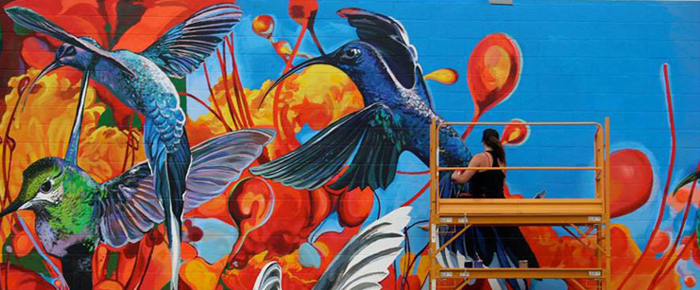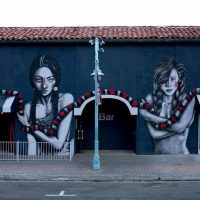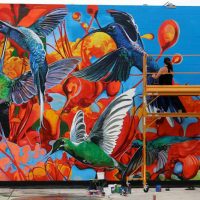
By Heidi Simmons
At the North Shore, set against the backdrop of the vast Salton Sea, a landscape with a scattered population and sparse community, there on the side of a small, family owned market, is a mural. In the center of the painted wall is a majestic maiden flanked by two snake-baring muses. The title is “Shesha Sand Storm” by artists Fin DAC and Angelina Christina. The mural boldly binds the sky to the earth elevating the remote unincorporated location to a place of artistic gravity.
“Murals bring a lot of life to communities,” said Christina. “Where you have otherwise a blank wall, with a mural you have a whole other world that inspires people. It’s beautiful.” When Christina first saw the North Shore market’s plain wall, she immediately wanted to paint. It was something she just had to do. The market’s owner was happy to accommodate her compulsion to create something meaningful. He paid her and DAC in snacks, sodas and heart-felt gratitude.
From the east of the Coachella Valley to the west, quality murals have become a part of the CV’s growing artistic signature. Coachella, Desert Hot Springs, Indio are a few of the cities who have embraced murals as important public art. Besides the painting of walls, many cities have covered utility boxes with colorful images creating points of artistic interest on busy corners.
Murals have become a way for cities to express personality, tell a story, share history, engage visitors, kindle ideas, deter vandals, stimulate economy, generate pride and bring color into their community. All eight of the valley’s cities have a process to incorporate art into their neighborhoods. And murals are finding their place.
The financing of public murals is done in many creative ways. There are grants, art collectives and organizations that contribute to mural projects. There are business and private sponsorships. Cities can contribute monetarily with funds set aside for public art. Artists are hired for their original ideas or on a commission. More often than not, the artist takes a token payment. Many street artists donate their skills as well as materials.
For Coachella Valley cities, Art in Public Places (APP) is a program that each has embraced as a way to finance art projects within city limits. APP is intended to “promote the general welfare of the public through the acquisition and installation of public artwork for the betterment of a community.” APP is one source for the funding of murals.
Palm Desert was the first valley city to have an APP program. The way the ordinance works is residential or commercial developments with a budget over $100,000 are charged an APP fee, which is a fraction of a percent of the overall budget. Once the art is selected, approved, commissioned and placed in its location, the money is refunded and the property owner then maintains the art. Palm Desert has been a model for the APP ordinance. Local governments use Development Impact fees in varying ways. But by law, APP funds can only be spent for public art.
“The APP program is a way to incorporate art into the fabric of the community,” said Deborah Schwartz, the Art in Public Places Coordinator. “Each city has an identification through art work. Different art work fits the flavor of the city.”
The only mural in Palm Desert is at the Desert Crossings Shopping Center. Tucked in the back corner, the mural is a trompe l’oeil — French for ‘deceives the eye.’ It depicts a modern woman gazing into a Moroccan courtyard as a veiled woman peers down from a villa window.
The collection of fees for the sake of art certainly enriches a community. Cities with more development of course have greater APP budgets. But it speaks volumes that each city, regardless of size, has embraced the APP ordinance. Each city decides the use of APP funds as well as the procedure to obtain or create the art.
In addition, all the incorporated CV cities have a process to approve art whether it is publicly funded by APP or paid for privately. City by city the mural process for approval varies. Most cities have specific commissions made up of residents, most of whom volunteer. Some cities include subcommittees with members from the community who are more “experienced” with art as a way to speed up the recommendation process.
With most CV cities, the job of commissions, committees, and subcommittees is to make recommendations to the governing body above them. All cities have codes and ordinances — some more than others when it comes to public placement of art and the painting of murals.
Gallery owner and artist Debra Mumm selected Palm Springs for a four-mural project to coincide with the 2014 Coachella Art and Music Festival — an enterprise that brings over 160,000 visitors to the valley. Mumm’s objective was to have internationally known muralists paint specific walls during the two weeks of the festival.
Business supported, the murals were to be all privately funded on privately owned space. “I picked Palm Springs because they seemed open and the easiest municipality for art approval,” said Mumm. “The idea was to develop an annual event.”
With walls matched to artists, the Palm Springs “mural festival” generated an early buzz. But before anyone could touch paint to plaster, the project was halted. With no mural code or ordinance, the city wanted time to put a review process and approval procedure in place. “I couldn’t believe it. I said ‘You can’t stop us now.’ And they said, ‘Yes we can’.” And they did.
Two weeks ago, Palm Springs passed a “Mural Approval” process and ordinance. The new code requires that a mural applicant begin with the Planning Commission to determine if the mural is a “sign” or “art.” If it is considered art, the drawing goes to the Public Arts Commission for input. The artwork must then be reviewed by the community and surrounding neighborhoods for feedback before a recommendation can be made. Finally, only the Palm Springs City Council can approve a mural.
Mumm was hugely disappointed to lose the momentum of the Palm Springs mural project. But now she says, “I’m hopeful it will be an easy process. I don’t know. I believe the city wants it. So we’re going to try again.”
The owners of Lulu California Bistro, along with the artist Apex, still intend to move ahead with their mural project. Lulu may be the first to submit a mural plan to the city.
“In all my research, I’ve found that there’s no downside to public art,” said Mumm. “Public art is just beneficial. So it’s an easy cause to get behind. It took years to get a sign ordinance in place and the city got the mural ordinance through in one month. I think it shows they really want it. And that means a lot.”
As of today, there are just two murals in the city.
Donavan Funkey owns Bar on Palm Canyon where a mural titled “The Mountain Charmers” covers the façade. It is of two beautiful women in face paint embraced by a huge California King snake. The art covers the entire front of the building.
Funkey did not set out to have a mural on the front of his establishment, but when he was introduced to Christina and DAC, he saw the quality of their work and decided to let the artists “have at it.”
After a brief conversation with a member of the Public Arts Commission, Funkey believed he was free to go ahead with the mural. When it came to the subject matter of the mural, Funkey said, “I let the artists do their thing.” He made no suggestions allowing the blank wall to inspire the artists.
Once the mural was painted on Bar, people started taking notice. As good art often does, it stimulated conversation — and some controversy. Whether being funded privately or publicly, it quickly became apparent that Palm Springs had no approval process for the painting of murals in public spaces.
However, Funkey is not worried about the future of the mural on Bar.
“I think what Palm Springs is doing is great,” said Funkey. “It’s good that they [the city] acted so quickly and took proactive steps to get something done. I’m excited to see what other murals will come of it.” Funkey trusts the approval process will be fair and reasonable when deciding about murals.
“You don’t want just anyone painting a mural,” Funkey said. “Forty thousand people have to look at it on a regular basis. A mural may be considered street art, but it rides the line of fine art.”
But the existing Palm Springs murals are not in the clear. According to Patrick Sheehan, Chairman of the Palm Springs Art Commission, Bar’s mural and the north Palm Springs mural by artist James Hunt, will not be grandfathered in with the new ordinance. Bar’s “The Mountain Charmers” will have to go through the new process to ultimately gain approval by the Palm Spring City Council.
With a similar idea of celebrating art and highlighting their community during Coachella Fest, the City of Coachella began the “Wall Project.” Local artists Armando Lerma and Carlos Ramirez of Date Farmers brought their idea to the city as a revitalization project in Coachella’s Downtown Pueblo Viejo District. Six artists from around the world are participating in the ongoing mural project. Acclaimed artists include El Mac and Andrew Hem.
The Date Farmer artists participated in a similar project in Florida called “Wynwood.” As often happens, a blighted community was changed after the murals were completed. The area turned into a hip arts and culture center with coffee shops, theaters and art galleries.
The City of Coachella is excited about its mural project. Its dynamic contribution to the community has already generated positive results. The city contributed $25,000 of APP money to the project for artist accommodations and materials. The artists all volunteered their time. Three of five murals have been completed and the city plans on producing more.
One of the valley’s oldest murals is in Cathedral City on Date Palm near Highway 111. It’s a trompe l’oeil of two fire engines parked inside a fire station. A Dalmatian sits nearby waiting patiently for the next call, while a boy admires the truck, his hands clasped behind his back. The artist is Gerry High. It was painted in 1999 and acquired in partnership with the “Paint the Town Program” and private donations. The painting was restored in 2011. A restoration video is on the city’s website.
Cathedral City now has an APP program. It has no mural requirements or ordinance. But the city has a Public Arts Commission and a mural projects subcommittee. When Mumm lost the opportunity to paint in Palm Springs, Cathedral City reached out to her as a place to be considered.
Besides the fire station, there is a mural that was privately financed and city approved on a bakery off Ramon Road. Two more private murals will be going up on highway 111. “We are keenly excited about the mural projects the city has on the horizon,” said Jim Cox, Chairman of the Public Arts Commission. “The private murals are just one phase. We have more mural projects we are considering now.”
In phase two, the city intends to use APP funds for a portrait of singer Lalo Guerrero. It will be a “pedigree” mural – allowing accomplished artists to apply for the project. Appropriately, the mural will be on Lalo Guerrero Road on the parking structure next to city hall. Guerrero was a resident of Cathedral City.
Cox hopes phase three will be a student mural on the city’s Public Works building. “Murals are more impactful and cost effective when using APP funds,” said Cox. “They get a lot of attention.”
Artist John Coleman is painting his third mural in Desert Hot Springs. His first mural is a city favorite on the new Save A Pet clinic on Palm Drive. Besides the murals, he has painted four utility boxes around the city with one more awaiting approval. The city has 111 boxes and so far 22 have been painted. The murals have been privately funded and the boxes have been paid by APP money.
“The city is easy to work with,” said Coleman. “There is a process that takes several weeks, but everybody wants to make the city more beautiful.” Coleman believes the artwork generates community pride.
He is currently working on a mural for the restaurant South of the Border also on Palm Drive. It’s of the mission San Juan Capistrano. Restaurant owner Fernando Guerrero said, “It’s not even done and people come in to say how much they like it.” Guerrero was happy the city approved the art. “I think murals are a nice addition to the community. They need to be done in good taste.”
As yet, Indian Wells has no murals. According to Warren Morelion, Marketing and Communications Director, the city has been collecting funds for their APP program. They are currently in the processes of developing two projects, although neither are murals. The city has no arts commission per se and anything related to art would be considered under the Planning Department or the Architecture Commission.
La Quinta is a community that takes great pride in its public art programs. The La Quinta Art Festival has been nationally recognized and the La Quinta Art Foundation is the only city to offer valley wide art scholarships.
“The city identifies itself with art and culture. It’s a big deal here,” said Edie Hylton, Community Services Director of La Quinta. “We have a lot of artists in the community and see ourselves as a cultural city. We want to use the APP money so everyone can see it.”
La Quinta has five murals. There are three outdoor murals done in large tiles – one at the carwash and two in Old La Quinta. The indoor murals are located in the Senior Center and the La Quinta Museum. The city has also painted all the signal boxes as part of APP.
The City of Indio has nine murals. On the city’s website, under Art in Public Places, the murals are listed and marked on a map for a self-tour. The murals can be viewed on the website and include the artist’s name, location, size and medium.
Nicole Ponsler painted mural number nine, “Rebirth,” in 2013. It is spectacular color pallet of hummingbirds in motion seeking nectar from local flora. The mural is on the side of a Quick & Easy store on Miles Avenue facing Kings Street.
“I love mural painting because of the challenge, because of the epic nature of the work and because of its accessibility,” said Ponsler. “I really believe in the power of art to heal, to inform and to effect change. The surrounding neighborhoods have a sense of pride and ownership in “Rebirth.” That, to me, is the greatest reward.”
There is little doubt that quality murals improve communities. Whether privately funded or when a city uses APP money, art makes an impact on the people who live in and visit a community.
“To create epic compositions intended for a diverse audience on a monumental scale, requires tenacity, a broad skill-set, vision, patience and fortitude,” said Ponsler. “Many things happen along the way, and yet somehow we succeed!” Ponsler credits all involved for the successes of public murals.
No doubt murals are a way of communicating directly with the public at large. Street art has grown in popularity and quality turning some artists into rock stars. It is a medium that represents freedom and ideas. Its nature is spontaneous. The big question is: How will the committee approval process affect the art?
“As street artists-muralists, we put everything we have into our work,” said Christina. “We don’t have a lot of time and money to do all the footwork required by some cities. If we have help from organizations or nonprofits that might be different, but as a solo artist just doing a piece, it reduces the inspiration and slims the availability and opportunity significantly.” In other words, it’s a buzz kill!
Christina understands that artist can be political or controversial, but she would prefer that a city paint over the art if they don’t like it, rather than “censorship by committee.” She has other concerns: “What if three people love it, but four don’t?” Although Christina certainly understands the reasoning on both sides, she worries the process will impact the integrity of the artistic work. She believes that artists should be embraced and not treated as a threat.
“In certain ways, murals are the strongest and the most meaningfully art because it’s the only art that is fully accessible to everyone,” said Christina. “No matter who you are — education, background — you have the opportunity to experience it in the same place as everyone else. That’s the most powerful thing about street art. It’s unconditional.”
Christina has painted murals all over the world and has observed, “The cities that are hungry for change, are hungry for art.” She’s found that ordinary people in Europe and South America embrace art with joy and passion. They are open to ideas and honored to have an artist paint on their walls.
“The North Shore painting would not have happened had it gone through a commission,” said Christina. “It was conceived on sight. The window of creativity, the organic beauty, would not have existed if the mural were planned.”
Murals are a remarkable form of art and communication. Hopefully, Coachella Valley cities are getting and sending the message: Public art is essential!













































